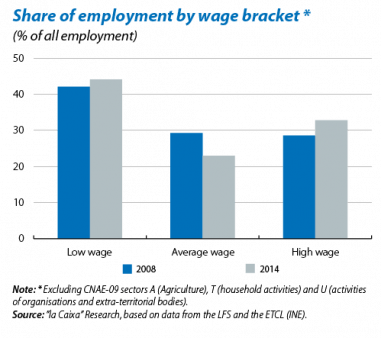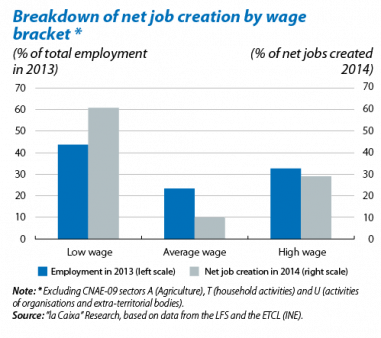Job polarisation in Spain
The progressive loss of jobs in sectors with average wages is known as «job polarisation». In Spain the percentage of employed in these sectors was 29.3% in 2008 compared with 23.0% in 2014.1 On the other hand, over this same period the share of employment in the low wage band and especially in the high wage band increased (see the first graph). This phenomenon of job polarisation is more or less evident in many developed countries.2 One of the main theories to explain this is that new technologies have reduced demand for workers carrying out routine tasks that can be easily mechanised (jobs that are mostly in the average wage band) while relative demand has increased for jobs that have a certain advantage over technology, either because they require more creativity or more manual or interpersonal skills (and these tend to be in the high and in the low wage band, respectively).3
In line with this theory, in Spain it can be seen that job losses occurring over the last few years have affected workers in the average wage band more than in any other. Specifically, the number of employees in this wage group in 2014 Q4 was 35% lower than in 2008 Q1 while the volume of workers fell by just 10% in the low wage band while the high wage band remained constant. The decline in the construction sector, which concentrates a large number of workers in the average wage band, lies behind a significant part of this trend. However, if this sector is excluded from the analysis, the loss of jobs in the average wage band is 20%, a drop that is still significant and much bigger than the job losses in the other two wage bands.
Job polarisation in Spain is not only related to the economic crisis: at the start of the recovery fewer jobs have been created in the average wage band than at the two extremes (see the second graph). If we compare the contribution made by each wage band to the jobs created in 2014 compared with their relative share in 2013, we can see that those economic sectors with a lower average wage contributed relatively more to creating jobs, given their share of the total. This group has therefore regained a significant proportion of the jobs lost during the crisis. Regarding the high wage band, in 2014 jobs were created in line with its relative share, a positive figure considering that this group is the one that has gained most share since 2008.
In short, the data reveal changing employment patterns in the Spanish economy with a significant delay in new jobs earning an average wage. Considering that one of the greatest risks of job polarisation is increased inequality, it is crucial to promote education that helps workers to take advantage of the opportunities provided by new technologies and thereby replace the average jobs lost with other, higher quality jobs.
1. The two-digit CNAE-09 economic sectors are classified into three wage brackets according to the hourly wage in the Quarterly Labour Cost Survey (ETCL in Spanish). For 2008, the sectors available in the ETCL (77 in total) are ordered from the lowest to the highest hourly wage, the cut-off value used for the three groups being the 1/3 percentile (corresponding to an hourly wage cost of 11.8 euros) and 2/3 percentile (15.8 euros).
2. See «Drivers of recent job polarisation and upgrading in Europe», European Jobs Monitor 2014, European Foundation for the Improvement of Living and Working Conditions.
3. See Goos, Manning and Salomons (2009), «Explaining Job Polarization: Routine-Biased Technological Change and Offshoring», The American Economic Review.




